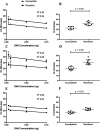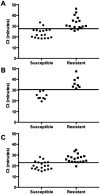A loop-mediated isothermal amplification (LAMP) assay to identify isotype 1 β-tubulin locus SNPs in synthetic double-stranded Haemonchus contortus DNA
- PMID: 35295940
- PMCID: PMC8901900
- DOI: 10.1007/s12639-021-01414-w
A loop-mediated isothermal amplification (LAMP) assay to identify isotype 1 β-tubulin locus SNPs in synthetic double-stranded Haemonchus contortus DNA
Abstract
Development of sustainable gastrointestinal nematode (GIN) control strategies depends on the ability to identify the frequencies of drug-susceptible and resistant genotypes in GIN populations arising from management practices undertaken on individual farms. Resistance to BZ drugs in GINs has been shown to be conferred by the presence of defined SNPs in the isotype 1 β-tubulin locus. Loop-mediated isothermal amplification (LAMP) assays are amenable to use on a range of DNA templates and are potentially adaptable to use in practical, cost-effective, pen-side diagnostic platforms that are needed to detect anthelmintic resistance in the field. In this study, we designed primers and examined LAMP assays to detect each of the three major isotype 1 β-tubulin SNPs conferring genetic susceptibility to BZ drugs. We used artificial pools of synthetic DNA, containing different proportions of susceptible and resistant SNPs to determine reproducibility of the assays. We demonstrated the detection of each of the isotype 1 β-tubulin SNPs conferring susceptibility to BZ drugs using the optimal LAMP assay. Isotype 1 β-tubulin SNP typing was effective in detecting BZ susceptibility, but the accuracy was reduced in samples with less than 60 % susceptible DNA. Our results show the potential for LAMP SNP typing to detect genetic susceptibility or resistance to anthelmintic drugs in livestock GINs, and some of the limitations in our approach that will need to be overcome in order to evaluate this assay using field samples.
Supplementary information: The online version contains supplementary material available at 10.1007/s12639-021-01414-w.
Keywords: Benzimidazole; LAMP; Nematode; Resistance; Small ruminant.
© The Author(s) 2021.
Conflict of interest statement
Conflict of interestSeamus Stack was an employee of Mast Group Ltd during development and optimisation of these LAMP assays. The authors are aware of no conflicting interests that could have influenced the conduct and reporting of these studies.
Figures



Similar articles
-
Development and evaluation of a loop-mediated isothermal amplification (LAMP) assay for the detection of the E198A SNP in the isotype-1 β-tubulin gene of Haemonchus contortus populations in China.Vet Parasitol. 2020 Feb;278:109040. doi: 10.1016/j.vetpar.2020.109040. Epub 2020 Jan 23. Vet Parasitol. 2020. PMID: 32007679
-
A detection of benzimidazole resistance-associated SNPs in the isotype-1 β-tubulin gene in Haemonchus contortus from wild blue sheep (Pseudois nayaur) sympatric with sheep in Helan Mountains, China.BMC Vet Res. 2019 Mar 12;15(1):89. doi: 10.1186/s12917-019-1838-4. BMC Vet Res. 2019. PMID: 30866931 Free PMC article.
-
Molecular analysis of benzimidazole-resistance associated SNPs in Haemonchus contortus populations of Uruguay.Vet Parasitol Reg Stud Reports. 2018 Aug;13:110-114. doi: 10.1016/j.vprsr.2018.05.001. Epub 2018 May 17. Vet Parasitol Reg Stud Reports. 2018. PMID: 31014856
-
Haemonchus contortus β-tubulin isotype 1 gene F200Y and F167Y SNPs are both selected by ivermectin and oxfendazole treatments with differing impacts on anthelmintic resistance.Vet Parasitol. 2017 Dec 15;248:90-95. doi: 10.1016/j.vetpar.2017.11.003. Epub 2017 Nov 7. Vet Parasitol. 2017. PMID: 29173548
-
Genetic analysis of a relationship between macrocyclic lactone and benzimidazole anthelmintic selection on Haemonchus contortus.Pharmacogenet Genomics. 2008 Feb;18(2):129-40. doi: 10.1097/FPC.0b013e3282f4711d. Pharmacogenet Genomics. 2008. PMID: 18192899
Cited by
-
Sensitive and rapid detection of Culex pipiens and Aedes albopictus.Front Insect Sci. 2023 Mar 2;3:1015695. doi: 10.3389/finsc.2023.1015695. eCollection 2023. Front Insect Sci. 2023. PMID: 38469538 Free PMC article.
-
Real-time single-base specific detection of the Haemonchus contortus S168T variant associated with levamisole resistance using loop-primer endonuclease cleavage loop-mediated isothermal amplification.Mol Cell Probes. 2024 Feb;73:101946. doi: 10.1016/j.mcp.2023.101946. Epub 2023 Dec 19. Mol Cell Probes. 2024. PMID: 38097144 Free PMC article.
-
In Silico Identification of Novel Compounds as Anthelmintics Against Haemonchus contortus Through Inhibiting β-Tubulin Isotype 1 and Glutathione S-Transferase.Animals (Basel). 2025 Jun 23;15(13):1846. doi: 10.3390/ani15131846. Animals (Basel). 2025. PMID: 40646745 Free PMC article.
References
-
- Avramenko RW, Redman EM, Melville L, Bartley Y, Wit J, Queiroz C, Bartley DJ, Gilleard JS. Deep amplicon sequencing as a powerful new tool to screen for sequence polymorphisms associated with anthelmintic resistance in parasitic nematode populations. Int J Parasitol. 2019;49:13–26. doi: 10.1016/j.ijpara.2018.10.005. - DOI - PubMed
LinkOut - more resources
Full Text Sources
Other Literature Sources
